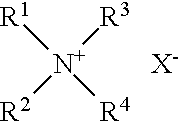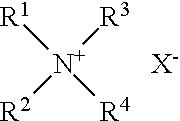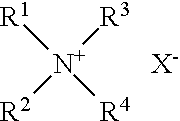Formula design for a solid laundry fabric softener
a technology of solid laundry fabric and formula, which is applied in the preparation of detergent mixture compositions, detergent compositions, detergent compounding agents, etc., can solve the problems of large shelf space in retail stores, high cost of shipping, and easy discoloration of solid laundry fabric, so as to achieve the effect of premium softness without yellowing or other fabric discoloration
- Summary
- Abstract
- Description
- Claims
- Application Information
AI Technical Summary
Benefits of technology
Problems solved by technology
Method used
Image
Examples
example 1
[0179]A fabric softness study was conducted to compare the fabric softening capability of a biodegradable high iodine value (HQ) triethanolamine (TEA) ester-quaternary ammonium compound to a nonbiodegradable low iodine value (LQ1) DHTDMAC quaternary ammonium compound. The low iodine value style quaternary ammonium compounds are known to provide fabric softening and this study was conducted to compare the fabric softening capability. A total of 20 consecutive laundering cycles—involving both wash and dry cycles—were performed on two sets of linens comprising cotton terry towels. All treatment towels were scoured by running two consecutive wash cycles using a high amount (7 oz / cwt) of an alkaline detergent. A 35-pound washer was filled with 28 pounds of cotton terry towels. The remaining wash and dry cycles were then run consecutively according to two different treatment systems set forth in Table 2. After the cycles were completed, the towels were kept in a controlled environmental c...
example 2
[0182]As the use of a DHTDMAC quaternary ammonium compound can result in linens becoming dim / dingy and losing water absorption / wicking capabilities, the impact of DHTDMAC quaternary ammonium compounds on the appearance of linens was assessed. To limit the negative impact of DHTDMAC quaternary ammonium compounds an amino-functional silicone was evaluated in combination to combat the undesirable effects of DHTDMAC quaternary ammonium compounds. However, the addition of liquid silicone to a solid fabric softener makes the formulations soft and leads to sloughing during dispensing. This undesirable effect on a solid is a limitation that must be overcome to develop a solid fabric softener composition that not only prevents dinginess and a reduction in wicking capabilities, but also sloughing and softness.
[0183]20 consecutive laundering cycles—involving both wash and dry cycles—were performed on two sets of linens comprising cotton terry towels. The sets of linen were subjected to three t...
example 3
[0186]Further solid softener weeping and sloughing analyses were conducted. 100-gram samples were prepared according to the formulations in Table 4. These formulations evaluated three different quaternary ammonium compound actives with different iodine values: a quaternary ammonium compound with a high iodine value (≥15) (HQ), and quaternary ammonium compounds with a low iodine value (≤15) (LQ1 and LQ2). Each quaternary ammonium compound was assessed at different concentrations: 33% for the high iodine value quaternary ammonium compounds, 11% for the low iodine value quaternary ammonium compounds. These concentrations were chosen based on the equivalent softening performance assessed in Example 1.
[0187]After the samples were prepared, they were chilled overnight below 0° C. The samples were allowed to come up to room temperature and were weighed to assess a starting weight. Then, in sets of eight, the specimen cup samples were placed on metal stands in a 120° F. water bath for two d...
PUM
| Property | Measurement | Unit |
|---|---|---|
| temperature | aaaaa | aaaaa |
| temperature | aaaaa | aaaaa |
| temperature | aaaaa | aaaaa |
Abstract
Description
Claims
Application Information
 Login to View More
Login to View More - R&D
- Intellectual Property
- Life Sciences
- Materials
- Tech Scout
- Unparalleled Data Quality
- Higher Quality Content
- 60% Fewer Hallucinations
Browse by: Latest US Patents, China's latest patents, Technical Efficacy Thesaurus, Application Domain, Technology Topic, Popular Technical Reports.
© 2025 PatSnap. All rights reserved.Legal|Privacy policy|Modern Slavery Act Transparency Statement|Sitemap|About US| Contact US: help@patsnap.com



